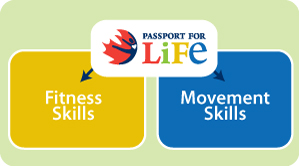The Fitness Skills and Movement Skills assessments include three tasks each—all physical tasks. The teacher sets up the tasks, observes and assesses each student using the Assessment Rubrics and Recording Forms. Please refer to the PDF document titled “Assessments” for downloadable and printable PDF version of the surveys or follow the Recording Forms link from the Teacher Dashboard.

Fitness Skills
Some people have less-than-fond memories of fitness testing because of inappropriate practices. Negative physical education experiences may have turned some people off physical activity. The role of physical education is to help children and youth develop skills, to inspire them to act and to build a sense of competence that can be applied to other areas of life. For these reasons, the ABC (Aerobic, Balance, Core) Fit assessment structure is designed to foster a positive and challenging environment that inspires children and youth to be aware of and interested in their fitness levels while taking steps to engage in a lifetime of play, activity, and exercise.
ABC Fit in Passport for Life consists of the following components and assessments:
| Component | Passport for Life Assessment |
| Aerobic/Cardiovascular Endurance (one of the best indicators of overall health) | Four-Station Circuit |
| Balance/Dynamic Stability (used on a daily basis/the foundation for all movemement) | Lateral Bound or Hexagon Jump |
| Core Strength (engine of the body that bridges lower body and upper body) | Plank |
Movement Skills
Fundamental movement skills are a core component of physical literacy. They provide the foundation—or building blocks—of more complex skills used in games, activities, sports and leisure pursuits. Fundamental movement skills are not static over a lifetime but are always evolving. They are one of the most important factors that contribute to physical activity participation because, without a certain level of proficiency, a person is much less likely to enjoy participating. In other words, if educators improve fundamental movement skills through appropriate instruction and practice, there is increased likelihood that participants will engage in activities that require those skills.
In the Movement Skills component of Passport for Life, running (locomotion), throwing and catching (object control) and kicking (object manipulation) will be assessed as key features of physical literacy.
